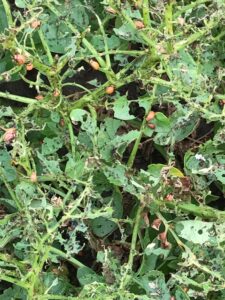
Emergence of elicitors
The concept of integrated pest management includes environmentally sustainable and economically effective approaches to control pests that rely on a complex combination of a series of control options. Those control options include breeding, monitoring, cultural, physical, biological, biorational and chemical practices.
Chemical control is an important part of pest management programs; however, pesticides can cause problems if not used correctly. Problems can include pesticide residues, crop damage, reducing biological control populations or decreasing the quality of human and animal health while damaging the environment (Figure 1).

In the literature, there are several cases of insects, weeds and diseases developing resistance to pesticides. In the insect world, one of the most famous cases of resistance is that of the Colorado potato beetle (Figure 2). To make the story short, it is well documented that the Colorado potato beetle is responsible for the development of the insecticide industry.
Impressively, in some documented cases, this insect has broken a mode of action after one year in the market (e.g., endrin) or even during the first year of use (e.g., oxamyl) (Figure 3). Now, the Colorado potato beetle population in the eastern part of the U.S. has developed resistance to all modes of action, in some cases in a very short time frame.

The first case of resistance to synthetic organic pesticides was observed for DDT in 1952, followed by dieldrin in 1958, and other chlorinated hydrocarbons. In following years, the beetle developed resistance to numerous organophosphates and carbamates. Currently, the Colorado potato beetle is resistant to arsenicals, organochlorines, carbamates, organophosphates and pyrethroids.
The major problem area for resistance is the northeastern U.S.; however, resistance has also been detected in other areas of the country, including the West, as well as in Canada, Europe and Asia.

INTRODUCING ELICITORS
Elicitors are chemical compounds that induce the plant’s immune system. They are classified as pathogen-derived or exogenous elicitors and plant-derived or endogenous elicitors. In other words, some are induced by external factors and others are not.
In a cascade of biochemical reactions, elicitors trigger signals in plants, predominantly resulting in the upregulation of phytohormone systems. The principal phytohormone system in plant-biotic interactions are the jasmonic acid (JA), salicylic acid (SA), and ethylene system. These phytohormones can occur naturally in plants or can be synthesized for optimal configuration and applied as sort of a “vaccination” to a plant.
Synthetic elicitors have been studied with mixed results in many cultivated crops including cranberries and other small fruits. To our knowledge, they have not been well documented in potatoes, especially from the applied perspective.
The challenge for applied studies of elicitors is the complex interaction between the signal that the plant receives from the elicitor and all the other signals the plant receives from external outputs. In general terms, the JA and ethylene pathways are associated with chewing insects and necrotrophic pathogens, while the SA pathway is associated with piercing/sucking insects.
In field conditions where the plant is exposed to both pathogen as well as effectors from the insect and their microbial endosymbionts, the action and efficacy of a synthetic elicitor is highly variable. An understanding of this “cross talk” is needed (meaning more research) among all components of the system.
BASELINE INFORMATION
In 2021 and 2022, as part of a student research project, we conducted a series of bioassays and greenhouse trials to evaluate the efficacy of synthetic elicitors to protect Russet Burbank against the Colorado potato beetle. Fitness of the insect was measured in relationship of its biological characteristics of weight, developmental time and general fitness (Figure 5).

Three products were tested: SA-type (Actigard 50WG), JA-type (Blush 2x), and an elicitor with both SA and JA activity (Regalia); water was used as a control. Plants were sprayed at either the leaf development or flowering stage to assess how plant phenology affects plant-insect responses.
One day after treatment application, plants were infested with five Colorado potato beetle larvae. Preliminary data suggest that elicitors, particularly those that induce a JA-dependent response, can lower larval fitness, and therefore a reduction in defoliation was observed.
This study only used a single potato variety but could potentially be expanded into including other varieties, because each may respond differently to insect feeding based on chemical composition, trichomes and other factors that we plan to investigate.
The student is also looking into evaluating the force which an insect like the Colorado potato beetle uses to shear leaves. This is a study developed to reinforce the plants’ constitutive defenses against this pest.
This article intends to briefly introduce the reader to a new concept: elicitors and how these chemical components could help protect crops while reducing the development of pesticide resistance. Elicitors could also provide some evidence of their efficacy while highlighting the challenges associated with incorporating elicitors into an integrated pest management program. It is our hope that this article will pique curiosity and foster more investigation that could provide research-based information into another tool in our current management programs for potatoes.














